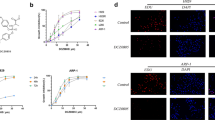Summary
This study was designed to determine the impact of chrysoeriol on proliferation and cell cycle progression in the human multiple myeloma cell lines RPMI 8226 and KM3, and its related molecular mechanisms. Chryseoriol was identified by using the phosphorylated AKT-specific cytoblot high throughput assay. CCK-8 assay was employed to examine the growth inhibition rate and IC50 (48 h) in peripheral blood mononuclear cells (PBMNCs), RPMI 8226 and KM3 cells treated with chrysoeriol at various concentrations. Cells were labeled with 5–6-carboxyfluorescein diacetate succinimidyl ester (CFSE), and the proliferation dynamics was detected by flow cytometry and analyzed with ModFit software. The cell cycles of RPMI 8226 and KM3 cells were measured by flow cytometry when the IC50 concentration of chrysoeriol was adopted. The alterations in cell-cycle related proteins (Cyclin B1, Cyclin D1, p21) and proteins in PI3K-AKT-mTOR pathway were determined by Western blot analysis. The results showed the proliferation of multiple myeloma cells was significantly inhibited by chrysoeriol, resulting in cell cycle arrest in G2/M phase. Chrysoeriol could significantly reduce the expression of p-AKT (s473) and p-4eBP1 (t37/46) protein, meanwhile enhanced Cyclin B1 and p21 protein expression. Similar effects were not observed in PBMNCs from normal donors. It was concluded that chrysoeriol was a selective PI3K-AKT-mTOR pathway inhibitor. It restrained the proliferation of human multiple myeloma cells, but didn’t affect proliferation of PBMNCs from normal donors. It might exhibit the cell cycle regulatory effect via the inhibition of PI3K-AKT-mTOR signal pathway.
Similar content being viewed by others
Change history
11 January 2021
An Erratum to this paper has been published: https://doi.org/10.1007/s11596-020-2309-7
References
Jacinto E, Loewith R, Schmidt A, et al. Mammalian TOR complex 2 controls the actin cytoskeleton and is rapamycin insensitive. Nat Cell Biol, 2004,6(11):1122–1128
Sarbassov DD, Guertin DA, Ali SM, et al. Phosphorylation and regulation of Akt/PKB by the rictor-mTOR complex. Science, 2005,307(5712):1098–1101
Duke JA, Bogenschutz MJ, Du CJ, et al. Handbook of Medicinal Herbs. 2nd ed. USA: CRC Press, 2002,612–613
Schinella GR, Giner RM, Recio MC, et al. Anti-inflammatory effects of South American Tanacetum vulgare. J Pharm Pharmacol, 1998,50(9):1069–1074
Han LK, Sumiyoshi M, Zheng YN, et al. Anti-obesity action of Salix matsudana leaves (Part 2). Isolation of anti-obesity effectors from polyphenol fractions of Salix matsudana. Phytother Res, 2003,17(10):1195–1198
Kim JH, Cho YH, Park SM, et al. Antioxidants and inhibitor of matrix metalloproteinase-1 expression from leaves of Zostera marina L. Arch Pharm Res, 2004,27(2):177–183
Choi DY, Lee JY, Kim MR, et al. Chrysoeriol potently inhibits the induction of nitric oxide synthase by blocking AP-1 activation. J Biomed Sci, 2005,12(6):949–959
Snijman PW, Swanevelder S, Joubert E, et al. The antimutagenic activity of the major flavonoids of rooibos (Aspalathus linearis): some dose-response effects on mutagen activation-flavonoid interactions. Mutat Res, 2007,631(2):111–123
Takemura H, Uchiyama H, Ohura T, et al. A methoxyflavonoid, chrysoeriol, selectively inhibits the formation of a carcinogenic estrogen metabolite in MCF-7 breast cancer cells. J Steroid Biochem Mol Biol, 2010,118(1–2):70–76
Seidl S, Kaufmann H, Drach J, et al. New insights into the pathophysiology of multiple myeloma. Lancet Oncol, 2003,4(9):557–564
Yang J, Shamji A, Matchacheep S, et al. Identification of a small-molecule inhibitor of class Ia PI3Ks with cell-based screening. Chem Biol, 2007,14(4):371–377
Chun KH, Kosmeder JW 2nd, Sun S, et al. Effects of deguelin on the phosphatidylinositol 3-kinase/Akt pathway and apoptosis in premalignant human bronchial epithelial cells. J Natl Cancer Inst, 2003,95(4):291–302
Cully M, You H, Levine AJ, et al. Beyond PTEN mutations: the PI3K pathway as an integrator of multiple inputs during tumorigenesis. Nat Rev Cancer, 2006,6(3):184–192
Hay N. The Akt-mTOR tango and its relevance to cancer. Cancer Cell, 2005,8(3):179–183
Grunwald V, DeGraffenried L, Russel D, et al. Inhibitors of mTOR reverse doxorubicin resistance conferred by PTEN status in prostate cancer cells. Cancer Res, 2002,62(21):6141–6145
Memmott RM, Dennis PA. Akt-dependent and -independent mechanisms of mTOR regulation in cancer. Cell Signal, 2009,21(5):656–664
Strimpakos AS, Karapanagiotou EM, Saif MW, et al. The role of mTOR in the management of solid tumors: an overview. Cancer Treat Rev, 2009,35(2):148–159
Cha BY, Shi WL, Yonezawa T, et al. An inhibitory effect of chrysoeriol on platelet-derived growth factor (PDGF)-induced proliferation and PDGF receptor signaling in human aortic smooth muscle cells. J Pharmacol Sci, 2009,110(1):105–110
Wendel HG, De Stanchina E, Fridman JS, et al. Survival signaling by Akt and eIF4E in oncogenesis and cancer therapy. Nature, 2004,428(6980):332–337
Garcia Echeverria C, Sellers WR. Drug discovery approaches targeting the PI3K/Akt pathway in cancer. Oncogene, 2008,27(41):5511–5526
Nasmyth K. Viewpoint: putting the cell cycle in order. Science, 1996,274(5293):1643–1645
Cappelletti V, Fioravanti L, Miodini P, et al. Genistein blocks breast cancer cells in the G (2) M phase of the cell cycle. J Cell Biochem, 2000,79(4):594–600
Bjornsti MA, Houghton PJ. The TOR pathway: a target for cancer therapy. Nat Rev Cancer, 2004,4(5):335–348
Hoeffer CA, Klann E. mTOR signaling: at the crossroads of plasticity, memory and disease. Trends Neurosci, 2010,33(2):67–75
Author information
Authors and Affiliations
Corresponding author
Additional information
This project was supported by grants from the National Natural Sciences Foundation of China (No. 30770914; No. 30901587) and China State Key Basic Research Program (No. 2002CB513100).
Rights and permissions
About this article
Cite this article
Yang, Y., Zhou, X., Xiao, M. et al. Discovery of chrysoeriol, a PI3K-AKT-mTOR pathway inhibitor with potent antitumor activity against human multiple myeloma cells in vitro . J. Huazhong Univ. Sci. Technol. [Med. Sci.] 30, 734–740 (2010). https://doi.org/10.1007/s11596-010-0649-4
Received:
Published:
Issue Date:
DOI: https://doi.org/10.1007/s11596-010-0649-4




